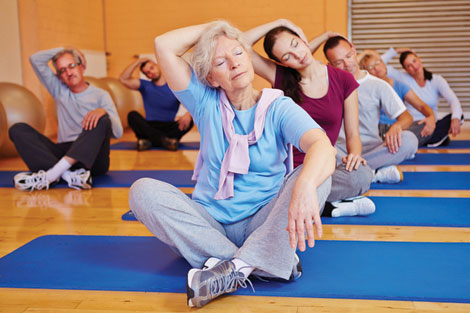We all experience times when we feel alone and are physically alone.
We might welcome some time on our own to get tasks done, sit quietly with a hot beverage or meditate in our thoughts.
Family caregivers could use a little alone time. Our seniors need it too, but on their own terms, not dictated by their situation.
Having some time alone can be a very good thing for our mental well-being. We need time to process our thoughts and decompress from a stressful situation.
The problem comes when, especially for our senior loved ones, too much time alone turns into a feeling of loneliness. It has been estimated by the National Institute on Aging that 19 percent of men and 37 percent of women over 65 are living alone. 43 percent overall report feeling lonely on a regular basis. Some estimates put the number of people in the U.S. who report feeling lonely at 60 million, or 20 percent of the population.
Loneliness is defined as a state of sadness brought on by having no friends or company, being remote and isolated. When compared to being alone, it is usually a negative condition and described as unpleasant.
Seniors don’t have to be alone to feel lonely. Feelings of loneliness are often accompanied by physical feelings such as anxiety, increased risk of heart disease and stroke, high blood pressure (as much as 30 additional points), and even obesity. People with prolonged loneliness frequently have higher cortisol levels (hormone) which can result in depression, digestive problems, sleep problems and obesity.
Seniors who report feeling lonely are more prone to physical decline and have a greater mortality rate.
Loneliness can impair cognitive function. Not surprisingly, older adults who feel lonely are more likely to behave in ways that make other people want to avoid being around them. This could further enhance their feeling of loneliness.
Causes of loneliness
Feeling left out of the action can be hard for seniors who are living alone. They may wonder why their families and friends aren’t visiting, calling or wanting to socialize as they once did.
Perhaps some of our senior loved ones are unable to drive themselves or have other obstacles to visiting friends and family members on their own, which could further make them feel isolated and lonely.
Seniors may not fully appreciate that others are busy and it isn’t really a personal affront. Unfortunately, this doesn’t make them feel any less lonely.
Sometimes our senior loved one’s friends stop visiting because seniors have changed and they aren’t as they remember them and just lose track. They may not be able to handle their own aging so that visiting with our senior loved one becomes too much of a reality check that they aren’t ready to confront.
“Why do I want to hang out with old people†is something we’ve heard many facility dwelling seniors say about their peers, not realizing that they are them too!
Our seniors may be dealing with the loss of a close relationship such as a spouse or dear friend. Perhaps the one with whom they shared their adult life is no longer there, nobody to sit with or eat with and no one to talk with about big or small things can be hard for seniors.
Many seniors face the notion that they are the last of their generation in the family – siblings are gone, parents are long gone, spouse may be lost and now their close friends are gone too.
Grieving and healing from this personal loss is hard enough except now they may be alone with no one left to share their grief.
Loneliness is sure to follow without some other intervention.
Many seniors eat meals – most of their meals in fact – alone each day when they are aging in place.
Not just sitting down at the table or in front of the TV using a tray by themselves, but having to prepare a meal for themselves without being able to cook for others can be a source of loneliness for many seniors.
The danger for seniors who cook for one and eat by themselves daily is that loss of social interaction. Eating is a social activity and an occasion for most of us, including our seniors. Seniors have lived most of their lives sharing their mealtime with others. Talking about the day, discussing the latest news, planning future events and reminiscing about prior history and fun times is missing when our seniors eat alone.
This missing piece can have a definite negative impact on our senior loved ones.
Eating alone can impact how much is eaten as well as the nutritional quality of the food they do eat. When you are cooking for yourself, opening a can of soup is easy and fast. Who wants to prepare a full meal for one, day after day?
How can family caregivers help?
Family caregivers who realize the potential risk of loneliness in their aging-in-place senior are on the right track. Understanding that this could be a problem will help caregivers.
-    Observe the situation and be alert to potential feelings of loneliness in your senior loved one. Do they look like they are often sad? Does anyone come to visit especially when you can’t make it often?
- Â Â Â Is there food in the pantry? Are they shopping or cooking? If not, family caregivers can help with prepared meals, initiating a home delivered meal, link seniors to the senior center for socialization and one good meal a day, shop with them (in person or online), bring food during visits or encouraging other family to bring a meal.
- Â Â Â Help your senior cook and freeze in batches so they have nutritious meals available without having to cook each day.
- Â Â Encourage your senior to invite others, such as a neighbor, church friend or relative, in for a meal from time to time.
- Â Â Â Help your senior make meal time more enjoyable by suggesting they play their favorite music, use fancy dishes for themselves (not just company) or light a flameless candle.
- Â Â Â Will their local restaurants deliver a meal so that they get a healthy meal without cooking? Can a family caregiver set that up for them, especially if at a long distance and unable to visit frequently?
-    Set up technology such as Skype, FaceTime or other video calling for family and friends so your senior can feel connected even when other people can’t come in person.
Find a virtual companion who can communicate with your senior so that they won’t feel like there is no one to listen to them. This is a great use of innovative technology.
If your senior loved one feels loneliness, it can be affecting their emotional and physical health. They may feel lonely even if they are not really alone because they are experiencing a loss.
Loneliness can happen when a person desires more social interaction than they are receiving so they may have visits but desire more. It is not about the number of interactions but more about the meaningfulness of the interaction.
While solitude can often be welcome, loneliness is not. Family caregivers should be alert to signs of loneliness in our senior loved ones and take action that can help prevent or reduce it.
Written by Kathy Birkett for Senior Care Corner (seniorcarecorner.com), an online provider of articles and information about senior-oriented topics such as aging in place, health and nutrition, Alzheimer’s and family caregiving.

